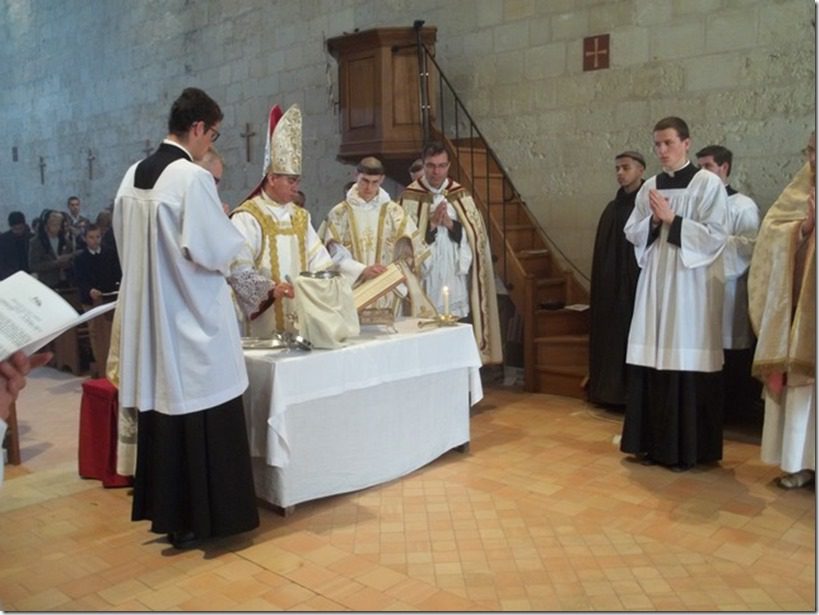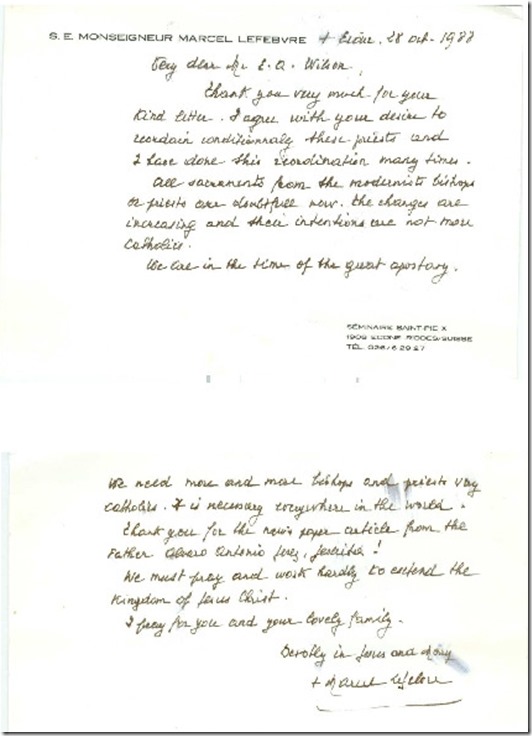Sermon of His Excellency Bp. Gerardo Zendejas
given in Avrillé (France)
for the Consecration of the Holy Oils
and Chrismal Mass of the Holy Thursday
April 18, 2019
Dear Rev. Prior, Priests, Brothers and Religious,
My Dear Brethren,
As Catholics, we believe that there are four marks in the Catholic Church: One, HOLY, Catholic and Apostolic. Needless to say that Catholic Church has the power to produce saints. This is the mark of sanctity. Absolutely God sends his grace from above as source of holiness. For that purpose Our Lord Jesus Christ has instituted seven sacraments in order to be a common way of sanctification, prefigured under the Mosaic Law and accomplished under the Law of the Gospel by the true and unique Messiah – our Lord Jesus Christ
A sacrament is a visible sign instituted by Jesus Christ in order to give grace, which we need for the eternal salvation of our soul. Taking human nature into account, Our Lord linked an invisible grace, for example to be child of God by adoption, to visible a sign – like water – when is used for Baptism. In other words, man stands in need of perceptible outward signs so that can realize and communicate spiritual realities. In a way, sacraments are symbols, however they signify what they perform.
Catholic Tradition has transmitted that there are three essential elements in a sacrament: matter, form and intention. Certainly, there is an immemorial use of OIL in the administration of some sacraments. For instance, it is essential to use Holy Chrism (a mix between Olive Oil and Balsam) in the administration of the Sacrament of Confirmation. Concerning the administration of sacraments in preserving their substance, Traditional teaching including the common teaching of the Church and theologians, have transmitted those matter, form and intention, and have religiously expressed them in prayers and gestures by the Roman Ritual or Eastern Liturgical Rites. Indeed, after SECOND VATICAN COUNCIL THESE RITES WERE MODIFIED. Why?
Here are some dates of modification:
1968 a new rite of priestly Ordination
1969 a New Mass
1969 a new rite of Baptism
1969 a new rite of Matrimony
1971 a new rite of Confirmation
1972 a new rite of Extreme Unction
1973 a new rite of Penance
1988 a new rite of exorcism, etc..
So, in 1970 there was installed a new matter for the holy Oils, not only enforcing a different kind of oil, but also granting the fact of blessed oils instead of consecrating them.
The new Rites – in general – do relativize the essential intention in administering Sacraments because undermine the truths of Catholic Faith. For instance, OLIVE OIL from Apostolic times was considered as the proper unique matter. The Ritual for the consecration of Holy Oils, which we are going to use in a few minutes, expresses during the preface that the olive oil was chosen among other trees for the signification of tree of peace and light – arbor pacis et lucis. It says that Noah had received some leaves of Olive tree, as signal of peace from God after the Deluge; also how Our Lord – praying in the Garden of Olives – willed to sanctify those olive trees in order to sanctify us when we offer ourselves to God, in particular when a person gives oneself to God in priestly or in religious life. In fact, for purpose of validity in administering the Sacrament of Confirmation the holy Chrism is essentially needed to be from olive oil mixed with balsam.
Otherwise, on December 3, 1970 the Congregation of Rites authorized the use of other vegetable oils in the administration of Sacraments, approved by Pope Paul VI. In addition, in canon 847 the new Canon Law (1983) reads: “In administering the sacraments in which holy oils must be used, the minister must use pressed olives OR OTHER PLANTS….. consecrated or BLESSED by a bishop.”
Nevertheless, the Congregation of Rites gave no reason to justify that something that has always been understood as INVALID (other kind of oil), later had suddenly considered to be VALID and enforceable. If Catholic Tradition has always refused to change the essential elements of the sacraments, it is because Jesus Christ has instituted them.
After Vatican II, very many priests had been erroneously indoctrinated through their preparatory years of formation, so that they could deliberately be weak in learning Tradition, and strong in Modernism. Their Novus Ordo modified ways in considering the sacraments, not only affect the priests’ believing but also the faithful’s beliefs in presiding community celebrations or interacting in social functions. Due to constant defects and excesses, the new Rites of sacraments are projecting a different way of believing.
That is the reason why Archbishop Lefebvre wisely RESISTED these innovations in order to preserve our Faith and the grace of God, so that the four marks of the Church could be preserved but in particular that one of Sanctity, for the Greater glory of God and the eternal salvation of many souls.
Let’s thank to Our Lord, during this ceremony, for the institution of the sacraments on Holy Thursday – the Holy Eucharist and Holy Orders because He also wanted to consecrate the ministers of the sacraments. That’s why He consecrated the first bishops in order to preach the Gospel throughout the world with its Traditions. We therefore should pray for the fidelity of Traditional Bishops, in spite that some of them want to play the betrayal role of Judas Iscariot.
In concluding, more than ever let’s thank to Notre Dame de Paris for having sent the French Prelate, Archbishop Lefebvre, to preserve our Catholic Episcopacy, and Catholic priesthood, in using the Traditional Rite of Sacraments, particularly that one of consecration of Holy Oils for their validity.
As the statue of Notre Dame remained safe after and in spite of last Monday burning fire, the Archbishop’s stands for Tradition shall remain safe in spite of the burning fire of Vatican II destructive innovations. Therefore, let’s once again thank to Notre Dame of Paris for remaining at the traditional main Altar in the Cathedral after last Monday burning fire, either way if it was provoked by accident or by incident, God knows. But what we really know is that in spite of such fire and smoke, Our Lady wanted to remain at the foot of her beloved Son’s cross, enhanced by Royal Crowns in Paris, as A TESTIMONY that the gates of hell will not prevail against the Mystical Body of Christ. The Catholic Church will not be destroyed, and Notre Dame of Paris Cathedral shall be restored. Absolutely, the Mother of God encourages us to keep the Deposit of the Faith transmitting the mystery of the Redemption, in spite of Vatican II diabolical confusion. The Cross of Our Lord Jesus Christ is always prevailing because He is True God, True Man and True King!!!
In the name of the Father, and of the Son, and of the Holy Ghost, AMEN


